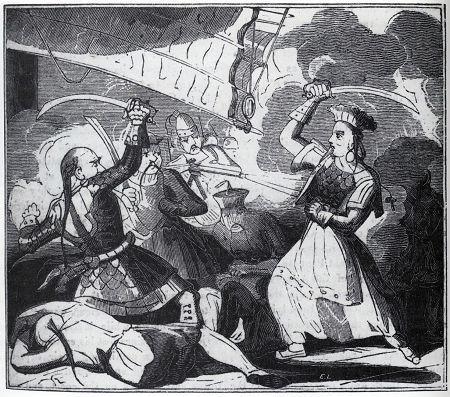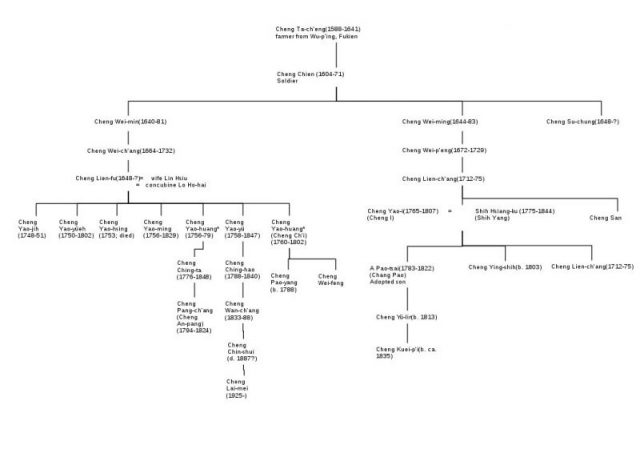At the beginning of the 19th century, in Qing Dynasty China, a woman rose through the ranks of a pirate fleet which looted and pillaged the Far East coast from the city of Canton to present-day Vietnam for decades.
Although sporting a number of names during her life, she became best known as Ching Shih, commandress of the Red Fleet.
Born as Shi Yang in the province of Guangdong, she entered the criminal underworld at an early age as a prostitute. Eventually, she became a madam in a Cantonese floating brothel and adopted an alias Shi Xianggu.

However, her role in the brothel wasn’t just handling the clients. It included many intrigues and dealing valuable information. Her wit combined with her beauty attracted a powerful and influential pirate lord called Cheng Yi, with whom she formed a marriage in 1801, enabling her to control over 50 percent of his fleet and loot. This was concluded in a formal agreement serving as a guarantee. Her husband commanded around 300 ships with more than 20,000 pirates, all gathered around the banner of the so-called Red Fleet.
Cheng himself was a man aware of the risks which came with the pirate enterprise, so apart from making sure his wife was his trusty right hand, he also adopted a young fisherman turned pirate called Cheung Po Tsai as his rightful male heir.

As if by providence, Cheng soon suffered a violent death. It is believed that he was murdered in Vietnam and that he was either 39 or 42 years of age at the time of his death.
His wife finally got the name under which she ruled the seas ― Ching Shih ― “The Widow of Cheng.”
In the meantime, weeks after her husband’s death, Ching and her then-stepson, Cheung Po Tsai, who was second-in-command, engaged in a love affair, which further strengthened the ties between the common pirates and the leadership of the Red Fleet.
Ching grew strong within the pirate community, earning loyalty and respect among the outlaws. But in order to achieve her status, she implemented a strict code of conduct which enabled her to forge a respectable naval force manned by disciplined and determined sailors.

The code included rules which strengthened the chain of command, punishing any form of violation or disobeying of orders with death. It also ensured that the villagers who supplied the pirates were protected as it was strictly forbidden to steal from them or hurt them in any way.
This rule helped in forming a strong network of trustworthy commonfolk who refused to provide the authorities with any information on the pirates. Of course, the Qing Dynasty which ruled China at the time did everything possible to put an end to her reign over the China Sea ― but with no success.
10 Bizarre Pirate traditions most people don’t know about
As for the loot itself, it was to be inspected by a group. It was then registered, with a part of it always going to a public fund intended to cover the expenses and repair damage. Twenty percent was given to the pirate who claimed the loot, while actual money always went to the squadron commander.
A special rule was enforced regarding women who were captured. Rape was punishable by death, while even consensual sex was prohibited as it meant death for both parties. However, accounts have been reported in which pirates were allowed to wed certain female captives.

Ching Shih’s fleet swelled in numbers, as she at one point reportedly commanded a force 80,000-strong. This number was cited by Richard Glasspoole, an officer aboard a British ship The Marquis of Ely, and an employee of the East India Company, who spent several months in captivity with the Red Fleet in 1809. He also estimated that Ching’s fleet numbered as much as 1,000 large junks and more than 800 smaller junks and rowboats.

Whether these numbers are exaggerated remains a subject of debate, but what is known is that the Red Fleet had made powerful enemies including the British and Portuguese Navies ― two of the most modern and respectable fleets of the time.
Ching Shih went undefeated for a number of years and amassed a huge fortune, but her partner’s arrogance ultimately brought about their downfall. In September 1809, Cheung Po decided to confront the Portuguese flotilla stationed at their city-colony of Macao by challenging them to a duel.
What went down in history as the Battle of the Tiger’s Mouth took place as a series of naval confrontations that marked the demise of a once powerful Red Fleet. Starting from September 1809, the fighting continued for several months, finally ending in January 1810.

After suffering several defeats and the defection of his vassals, Cheung Po together with Ching decided to accept the terms of surrender within the Qing amnesty which was enforced as a counter-pirate measure.
This was the official retirement of Ching Shih, who continued her life by marrying her former stepson with whom she lived until his death in 1822. After Cheung’s untimely death at sea, she moved back to her hometown of Canton, where she opened a brothel and gambling house.
Ching Shih successfully retired from piracy and spent the rest of her life peacefully, surrounded by family. She died in 1844, aged 69, leaving behind her a lasting legacy inspiring stories, books and even movies like the Pirates of the Caribbean, which features her as a character among the pirate lords.
Nikola Budanovic is a freelance journalist who has worked for various media outlets such as Vice, War History Online, The Vintage News, and Taste of Cinema. His main areas of interest are history, particularly military history, literature and film.
